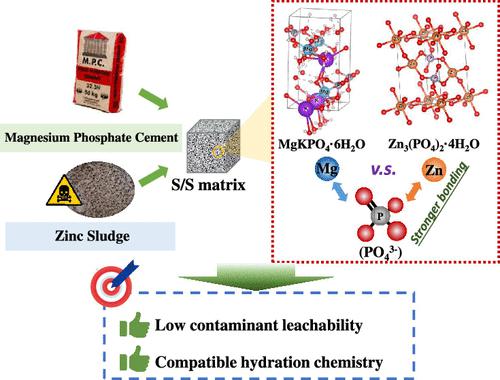当前位置:
X-MOL 学术
›
Environ. Sci. Technol.
›
论文详情
Our official English website, www.x-mol.net, welcomes your feedback! (Note: you will need to create a separate account there.)
Designing Magnesium Phosphate Cement for Stabilization/Solidification of Zn-Rich Electroplating Sludge
Environmental Science & Technology ( IF 11.4 ) Pub Date : 2022-06-23 , DOI: 10.1021/acs.est.2c01450 Yuying Zhang 1 , Zhonghao Wan 1 , Lei Wang 2 , Binglin Guo 3 , Bin Ma 4 , Liang Chen 1 , Daniel C W Tsang 1, 2
Environmental Science & Technology ( IF 11.4 ) Pub Date : 2022-06-23 , DOI: 10.1021/acs.est.2c01450 Yuying Zhang 1 , Zhonghao Wan 1 , Lei Wang 2 , Binglin Guo 3 , Bin Ma 4 , Liang Chen 1 , Daniel C W Tsang 1, 2
Affiliation

|
Electroplating sludge is a hazardous waste due to its high potential to leach toxic elements into the natural environment. To alleviate this issue, we tailored magnesium phosphate cement (MPC) as a low-carbon material for stabilization/solidification (S/S) of Zn-rich electroplating sludge. The interaction between MPC and ZnO was investigated to clarify the precipitate chemistry, microstructure transition, and chemical environment of Zn species in the MPC-treated Zn sludge system. Comprehensive characterization (by X-ray diffraction (XRD), 31P nuclear magnetic resonance (NMR), and extended X-ray absorption fine structure spectroscopy (EXAFS)) and thermodynamic modeling results revealed that the incorporated ZnO preferentially reacted with phosphate to form Zn3(PO4)2·2H2O/Zn3(PO4)2·4H2O, changing the orthophosphate environment in the MPC system. Stronger chemical bonding between Zn and phosphate in comparison to the bonding between Mg and phosphate also resulted in the formation of amorphous Zn3(PO4)2·2H2O/Zn3(PO4)2·4H2O. Zn3(PO4)2·4H2O precipitate appears to predominate at high {K+}{H+}{HPO42–} values, and the formation of Zn3(PO4)2·2H2O/Zn3(PO4)2·4H2O competed for the Mg sites in the MPC system, leading to the inhibition of formation of Mg–phosphate precipitates. Overall, this work uncovers the precipitate chemistry and microstructure transition of Zn species in the MPC system, providing new insights into the sustainable S/S of Zn-contaminated wastes by adopting MPC.
中文翻译:

设计用于稳定/固化富锌电镀污泥的磷酸镁水泥
电镀污泥是一种危险废物,因为它具有将有毒元素浸出到自然环境中的高潜力。为了缓解这个问题,我们定制了磷酸镁水泥 (MPC) 作为低碳材料,用于富锌电镀污泥的稳定/固化 (S/S)。研究了 MPC 和 ZnO 之间的相互作用,以阐明 MPC 处理的 Zn 污泥系统中 Zn 物种的沉淀化学、微观结构转变和化学环境。综合表征(通过 X 射线衍射 (XRD)、31 P 核磁共振 (NMR) 和扩展 X 射线吸收精细结构光谱 (EXAFS))和热力学建模结果表明,掺入的 ZnO 优先与磷酸盐反应形成 Zn 3(采购订单4) 2 ·2H 2 O/Zn 3 (PO 4 ) 2 ·4H 2 O,改变MPC系统中的正磷酸盐环境。与镁和磷酸盐之间的化学键相比,锌和磷酸盐之间更强的化学键也导致形成无定形Zn 3 (PO 4 ) 2 ·2H 2 O/Zn 3 (PO 4 ) 2 ·4H 2 O. Zn 3 ( PO 4 ) 2 ·4H 2 O 沉淀似乎在高 {K + }{H +}{HPO 4 2– } 值,Zn 3 (PO 4 ) 2 ·2H 2 O/Zn 3 (PO 4 ) 2 ·4H 2 O 竞争 MPC 系统中的 Mg 位点,导致抑制磷酸镁沉淀的形成。总体而言,这项工作揭示了 MPC 系统中 Zn 物种的沉淀化学和微观结构转变,为采用 MPC 的 Zn 污染废物的可持续 S/S 提供了新的见解。
更新日期:2022-06-23
中文翻译:

设计用于稳定/固化富锌电镀污泥的磷酸镁水泥
电镀污泥是一种危险废物,因为它具有将有毒元素浸出到自然环境中的高潜力。为了缓解这个问题,我们定制了磷酸镁水泥 (MPC) 作为低碳材料,用于富锌电镀污泥的稳定/固化 (S/S)。研究了 MPC 和 ZnO 之间的相互作用,以阐明 MPC 处理的 Zn 污泥系统中 Zn 物种的沉淀化学、微观结构转变和化学环境。综合表征(通过 X 射线衍射 (XRD)、31 P 核磁共振 (NMR) 和扩展 X 射线吸收精细结构光谱 (EXAFS))和热力学建模结果表明,掺入的 ZnO 优先与磷酸盐反应形成 Zn 3(采购订单4) 2 ·2H 2 O/Zn 3 (PO 4 ) 2 ·4H 2 O,改变MPC系统中的正磷酸盐环境。与镁和磷酸盐之间的化学键相比,锌和磷酸盐之间更强的化学键也导致形成无定形Zn 3 (PO 4 ) 2 ·2H 2 O/Zn 3 (PO 4 ) 2 ·4H 2 O. Zn 3 ( PO 4 ) 2 ·4H 2 O 沉淀似乎在高 {K + }{H +}{HPO 4 2– } 值,Zn 3 (PO 4 ) 2 ·2H 2 O/Zn 3 (PO 4 ) 2 ·4H 2 O 竞争 MPC 系统中的 Mg 位点,导致抑制磷酸镁沉淀的形成。总体而言,这项工作揭示了 MPC 系统中 Zn 物种的沉淀化学和微观结构转变,为采用 MPC 的 Zn 污染废物的可持续 S/S 提供了新的见解。


























 京公网安备 11010802027423号
京公网安备 11010802027423号